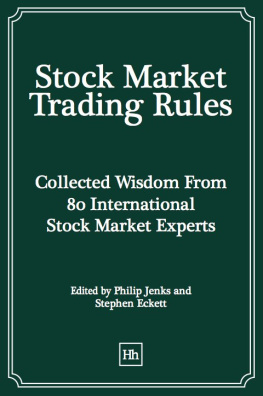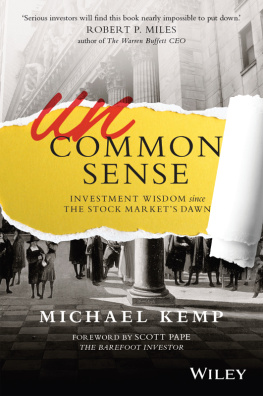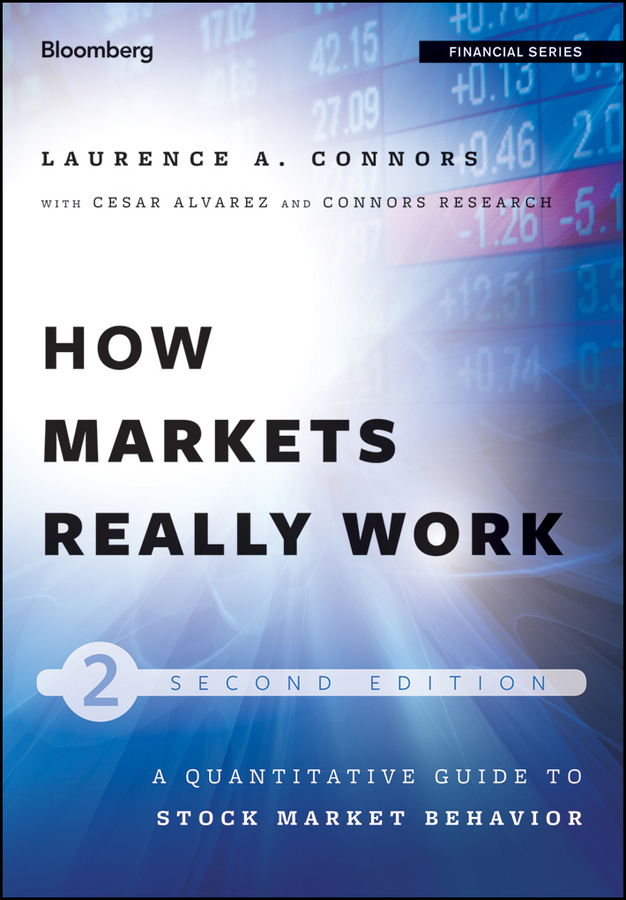Contents
Since 1996, Bloomberg Press has published books for financial professionals on investing, economics, and policy affecting investors. Titles are written by leading practitioners and authorities, and have been translated into more than 20 languages.
The Bloomberg Financial Series provides both core reference knowledge and actionable information for financial professionals. The books are written by experts familiar with the work flows, challenges, and demands of investment professionals who trade the markets, manage money, and analyze investments in their capacity of growing and protecting wealth, hedging risk, and generating revenue.
For a list of available titles, please visit our website at www.wiley.com/go/bloombergpress .

Copyright 2012 by Laurence A. Connors and Cesar Alvarez. All rights reserved.
Published by John Wiley & Sons, Inc., Hoboken, New Jersey.
Published simultaneously in Canada.
First edition published by The Connors Group in 2004.
No part of this publication may be reproduced, stored in a retrieval system, or transmitted in any form or by any means, electronic, mechanical, photocopying, recording, scanning, or otherwise, except as permitted under Section 107 or 108 of the 1976 United States Copyright Act, without either the prior written permission of the Publisher, or authorization through payment of the appropriate per-copy fee to the Copyright Clearance Center, Inc., 222 Rosewood Drive, Danvers, MA 01923, (978) 750-8400, fax (978) 646-8600, or on the Web at www.copyright.com . Requests to the Publisher for permission should be addressed to the Permissions Department, John Wiley & Sons, Inc., 111 River Street, Hoboken, NJ 07030, (201) 748-6011, fax (201) 748-6008, or online at www.wiley.com/go/permissions .
Limit of Liability/Disclaimer of Warranty: While the publisher and author have used their best efforts in preparing this book, they make no representations or warranties with respect to the accuracy or completeness of the contents of this book and specifically disclaim any implied warranties of merchantability or fitness for a particular purpose. No warranty may be created or extended by sales representatives or written sales materials. The advice and strategies contained herein may not be suitable for your situation. You should consult with a professional where appropriate. Neither the publisher nor author shall be liable for any loss of profit or any other commercial damages, including but not limited to special, incidental, consequential, or other damages.
For general information on our other products and services or for technical support, please contact our Customer Care Department within the United States at (800) 762-2974, outside the United States at (317) 572-3993 or fax (317) 572-4002.
Wiley also publishes its books in a variety of electronic formats. Some content that appears in print may not be available in electronic books. For more information about Wiley products, visit our website at www.wiley.com .
Library of Congress Cataloging-in-Publication Data:
Connors, Laurence A.
How markets really work : a quantitative guide to stock market behavior / Laurence A. Connors, Cesar Alvarez. Second edition.
1 online resource. (Bloomberg financial series; 158)
Includes index.
Description based on print version record and CIP data provided by publisher; resource not viewed.
ISBN 978-1-118-16650-5 (cloth); ISBN 978-1-118-22628-5 (ebk);
ISBN 978-1-118-23945-2 (ebk); ISBN 978-1-118-26420-1 (ebk);
1. Stock exchangesUnited States. I. Alvarez, Cesar, 1967 II. Title.
HG4910
332.642dc23
2011050882

Disclaimer
It should not be assumed that the methods, techniques, or indicators presented in this book will be profitable or that they will not result in losses. Past results are not necessarily indicative of future results. Examples in this book are for educational purposes only. The author, publishing firm, and any affiliates assume no responsibility for your trading results. This is not a solicitation of any order to buy or sell.
HYPOTHETICAL OR SIMULATED PERFORMANCE RESULTS HAVE CERTAIN INHERENT LIMITATIONS. UNLIKE AN ACTUAL PERFORMANCE RECORD, SIMULATED RESULTS DO NOT REPRESENT ACTUAL TRADING. ALSO, SINCE THE TRADES HAVE NOT ACTUALLY BEEN EXECUTED, THE RESULTS MAY HAVE UNDER- OR OVERCOMPENSATED FOR THE IMPACT, IF ANY, OF CERTAIN MARKET FACTORS, SUCH AS LACK OF LIQUIDITY. SIMULATED TRADING PROGRAMS IN GENERAL ARE ALSO SUBJECT TO THE FACT THAT THEY ARE DESIGNED WITH THE BENEFIT OF HINDSIGHT. NO REPRESENTATION IS BEING MADE THAT ANY ACCOUNT WILL OR IS LIKELY TO ACHIEVE PROFITS OR LOSSES SIMILAR TO THOSE SHOWN.
Table Explanation
Following is an explanation of each of the columns in the tables that appear at the end of Chapters 2 through 11.
1. The Index column indicates which market we tested, either the S&P 500 (SPX) or the Nasdaq 100 (NDX).
2. Rule 1 describes the first rule of the test. We would take a position only if this condition occurred.
3. Rule 2 is the second rule of the test, if applicable. If this column contains information, then both rule 1 and rule 2 must be in place to take a position. If this column is blank, then only rule 1 is needed.
4. The Time Period column indicates the length of a single test. 1 day means buy today, sell tomorrow. 1 week means buy today, exit five trading days from now.
5. The Gain/Loss column lists the average percentage gain or loss the market made while we were in the position with the specified rules.
6. The # Winners column tallies up the number of profitable tests for the given set of rules.
7. The # Days column tallies up the number of times that our set of rules produced a trade.
8. The % Profitable column is simply the number of winners divided by the total number of trades.
9. In every test we wanted to have a baseline for comparison. We called this our Benchmark Average. The benchmark average is the average percentage the market gained or lost during the specified time period overall length of the test interval. For instance, the average one-day gain of the S&P 500 from January 1989 to September 2011 was 0.03%.
10. The % Profitable Benchmark column serves as a profitability comparison between our trade signal and the typical market. It takes all market periods and calculates what percentage of them were profitable.
Acknowledgments
Special thank you to David Weilmuenster, Leigh Lommen, and Danilo Torres for their assistance in helping us with this book.
CHAPTER 1
Market Edges
The following is verbatim from the first edition of How Markets Really Work. Its important to get a point of reference of what we wrote and saw in 2004 compared to what we see with the second edition, which was written in late 2011.

For many of us, Michael Lewiss 1989 best-selling book Liars Poker was the first inside look at what day-to-day life was like at a major Wall Street trading firm. Lewis described in detail, the wheeling and dealing of some of the famous (and infamous) Wall Street titans who oversaw billions of dollars of transactions every trading day during the 1980s. The book remains a classic today but 14 years after it was published, Lewis outdid himself. In 2003, he published Moneyball: The Art of Winning an Unfair Game . The book chronicles the success of the Oakland As, who under the guidance of their general manager, Billy Beane, used massive amounts of statistical data to help them successfully run their ball team.











